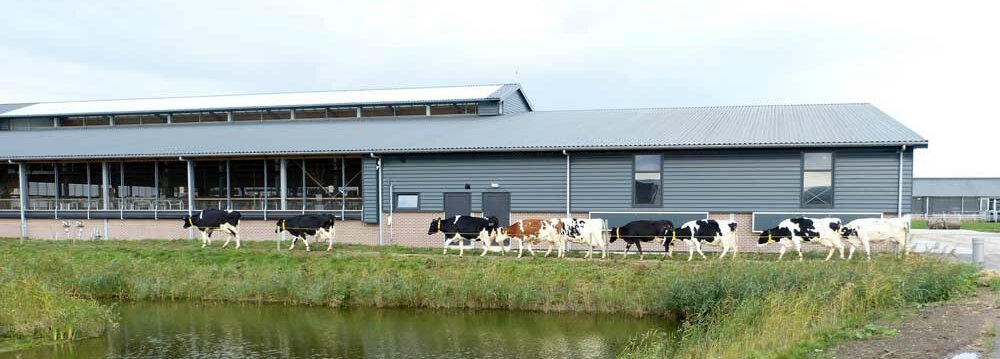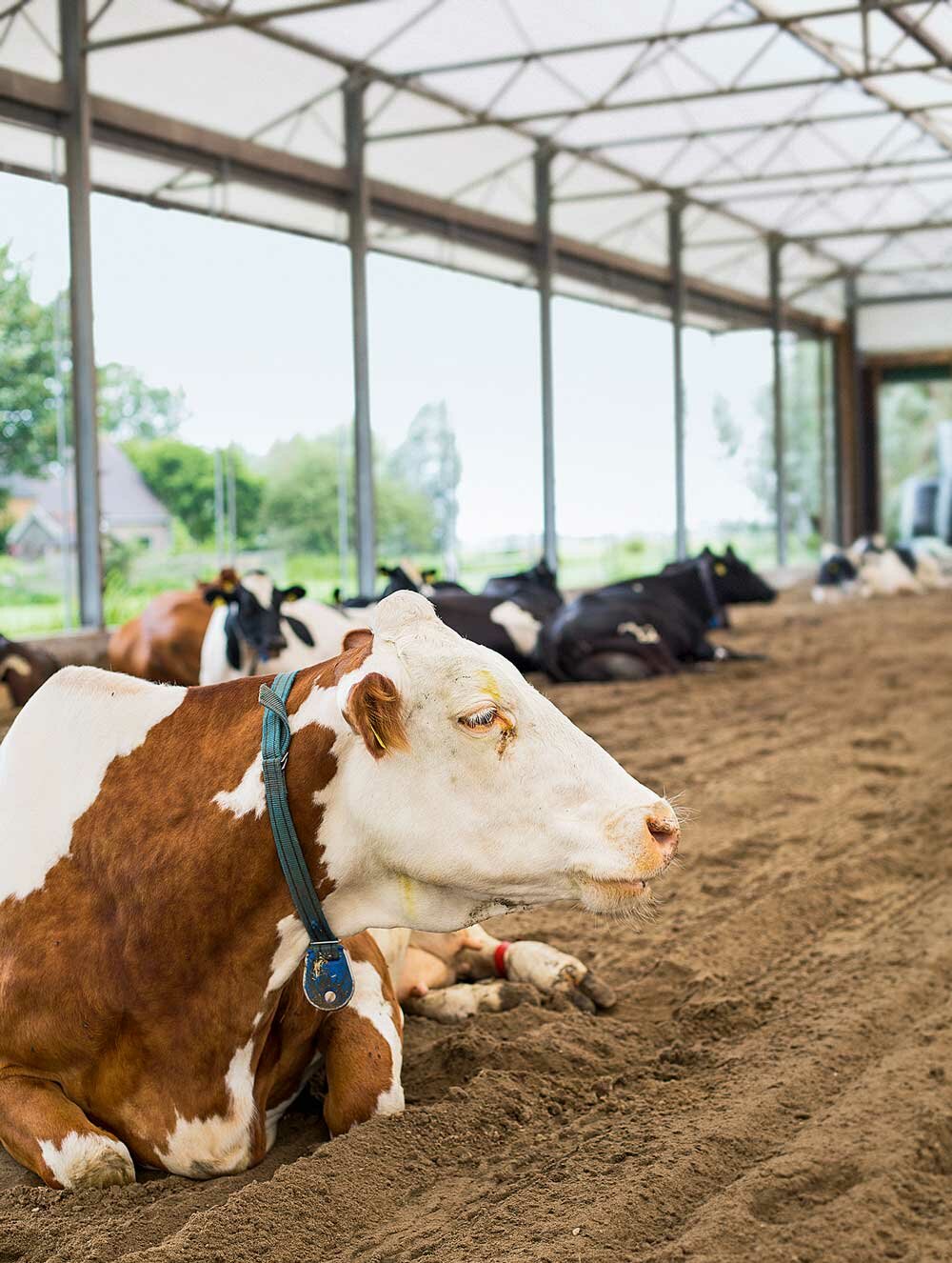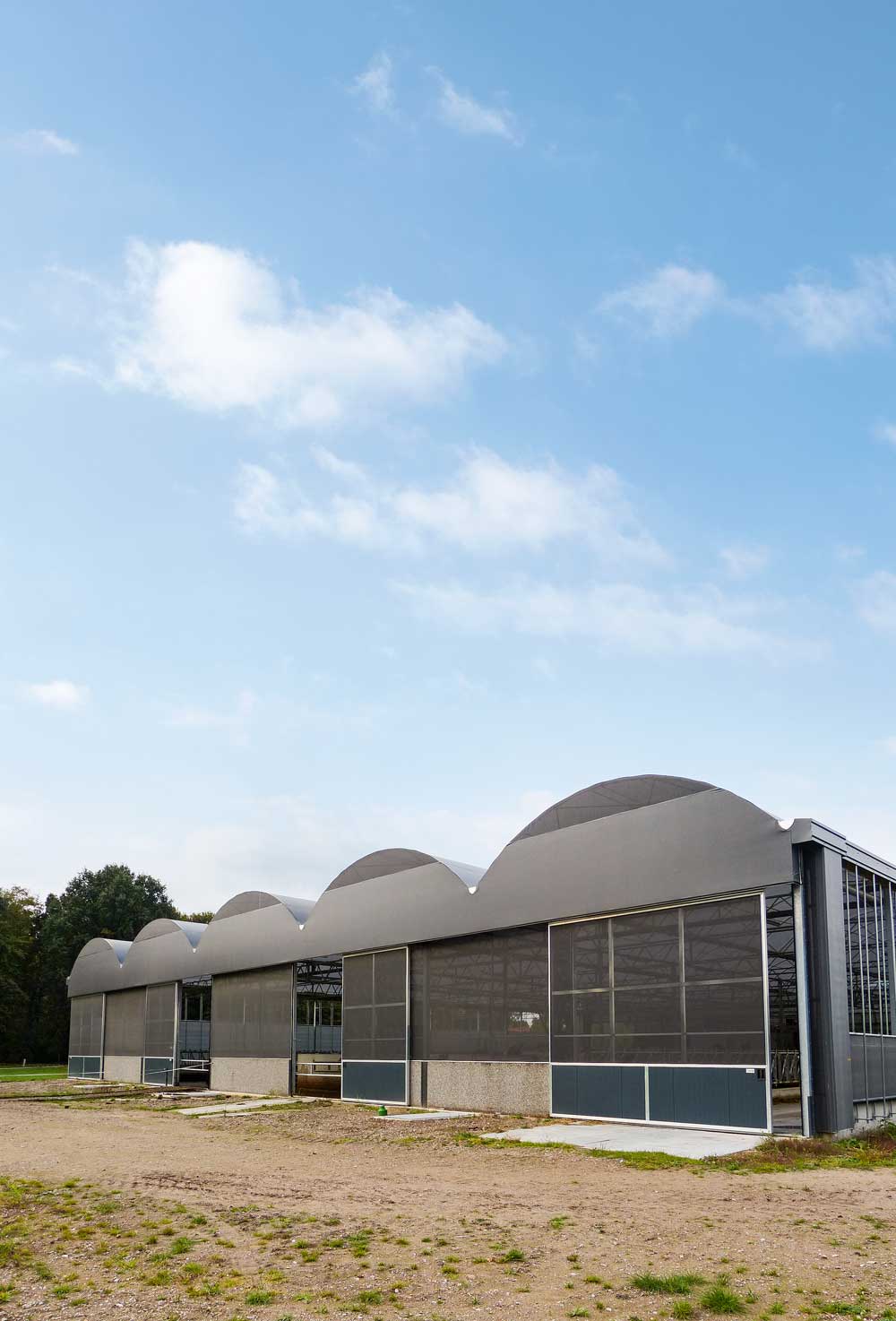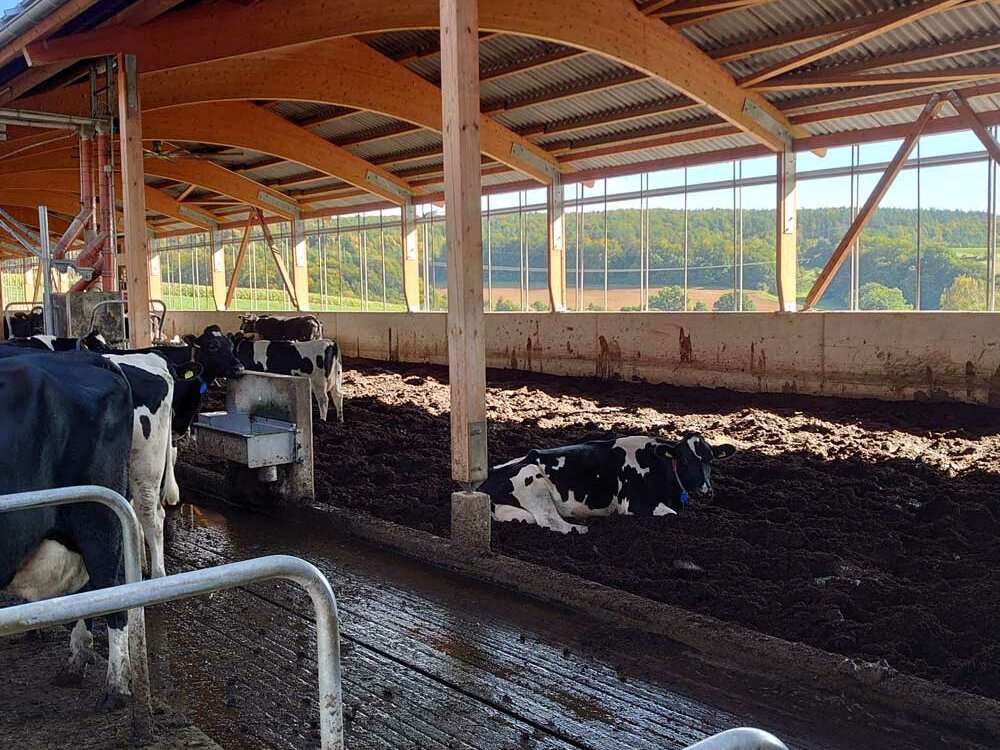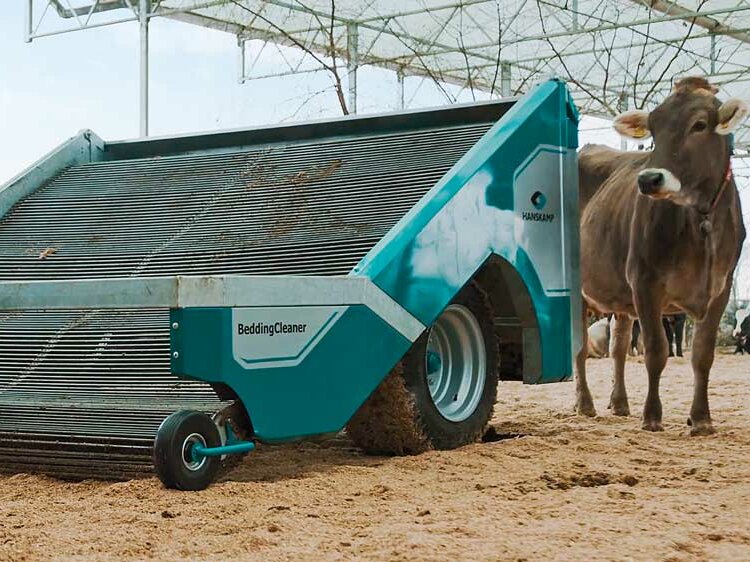On the way to more cow welfare
By Sibylle Möcklinghoff-Wicke, Dairy Innovation Team, Friedrichsdorf
The focus is increasingly on animal welfare, the discussion about greenhouse gases (GHG) and emissions (NH3, CH4 and N2O), and biodiversity. Dairy farming systems can influence all these aspects in different ways: Efficient production and healthier cows lead to more milk per cow with a lower carbon footprint. Innovative solutions for barn floors reduce emissions by bringing about the separation of faeces and urine, or bedding materials (in free stalls) act as biofilters. The manure substrate obtained can act as a soil conditioner (carbon sequestration). Long-lived, healthy cows lead to fewer young animals, and thus to fewer environmental influences.
So what housing systems can be used to respond to this?
Cows do not find enough comfort in many loose housing systems, but development is slow. Above all, technical innovations, changing requirements of the cows and also of the livestock farmers, the impact on the environment as well as society have led to the construction of different building systems in the past. Innovation is also the key to current and future development. However, here the solution must take into account both maximum cow comfort and potential environmental impact in equal measure.
Improvements are also constantly being sought in conventional cubicle housing. For example, in a recent trial in Canada, cubicle partitions were changed to free-hanging, movable partitions. The scientists investigated the effect of this greater freedom for the cow in terms of animal welfare and cleanliness. They came to the conclusion that movable stall partitions increase animal welfare compared to rigid partitions (among other things, less perching, i.e. standing with the front legs in and the hind legs outside the cubicle). Compared to the stall with a free lying area, the lying area was cleaner with the flexible partition.
More demands on animal welfare
However, many of today's husbandry practices for dairy cows are at odds with society's ideas of animal welfare. In public (i.e. outside the dairy industry), the importance of naturalness for dairy cows is usually emphasised, e.g. through grazing, freedom of movement and the opportunity to interact socially with conspecifics. However, this is not the standard in husbandry practices in many regions of the world. The majority of dairy cows are kept indoors all year round without any access to pasture. However, lack of access to pasture and restrictive husbandry systems are not only contrary to public expectations, but also to animal welfare. Dairy cows are highly motivated to go out to pasture and show a reduction in behavioural abnormalities when allowed out to pasture after periods of confinement. Calves kept without social contact have cognitive deficits and show increased fear responses to novelty. The long-term sustainability of dairy farming may depend on the extent to which housing systems can address public concerns and allow animals more freedom.
The importance of new technologies
The use of new technologies such as automatic feeding systems and remote monitoring systems can provide a means to practically encourage the natural behaviour of animals while improving individual care. Although older populations may view these technological solutions as another departure from naturalness and a move away from "farm-based dairy farming", the definition of "naturalness" may well have expanded to include them for younger generations. As purchasing power increasingly shifts to these younger generations, the introduction of technologies that encourage natural behaviour in cattle may be a means of bridging the gap between public perceptions of animal welfare and current dairy farming practices.
A look at the Netherlands shows which solutions are conceivable and can currently be implemented that go beyond the "classic cubicle pen". Free stalls such as composting stalls, which can now be found in many parts of the world, started their spread in Europe from the Netherlands at the end of the 2000s. There are now many positive examples in practice.
Cow comfort contra environment?
The sticking point is the bedding material. The NH3 emissions are lower than in conventional loose housing, but a final assessment of the situation regarding CH4 and N2O emissions is not yet available. That is why it is good that there is always further development of how to make stalls with free lying areas usable for many. Above all, they can improve animal welfare and make work easier and less tedious.
However, new developments in housing can conflict with other sustainability goals such as environmental protection. After all, more space means, for example, larger livestock buildings again. In this context, new solutions are needed that take all aspects of sustainability equally into account.
Due to the increased space requirements of free stalls compared to cubicle cubicles, it seems reasonable to think about combining these systems on the farm: all transit cows, which should have maximum comfort, are housed in a free stall and all productive cows are housed in a 2-row cubicle cubicle, in order to offer more space to the individual cow here as well.
Conclusion: Pasture into the barn
Housing systems and management practices exert a strong influence on the welfare of dairy cows. Cow health and welfare as well as milk and dairy product quality can benefit from free stalls. But future barn designs must offer maximum animal welfare and protection, as well as emission reduction, while enabling efficient and profitable production. Composting barns offer improved animal welfare, reduce NH3 emissions, but cannot currently offer a significant improvement in N2O and CH4 emissions. Innovations based on separate collection and storage of urine and solid manure are an interesting way to reduce emissions from dairy production and to produce manure products that can be used without expensive processing technology. However, separation alone is usually not enough, so further research and development is needed here as well.
The better we succeed in "bringing the pasture into the barn", the sooner we are likely to see social acceptance. In the future, we need solutions that integrate the environment, nature, animal welfare and economic efficiency: a "cow-topia".
How to bring the pasture into the barn?
A Dutch company has presented a new technical solution for the removal of manure from free stalls. It is an essential part of the "VrijLevenStal" concept and removes fresh cow dung from the litter. The machine acts like a mobile sieve: it picks up the top 2 to 3 cm of the litter material, sieves it and collects faeces and bound moisture in the integrated container. Clean, dry fine particles trickle through the sieve and become part of the flat lying surface again. The machine is currently in practical use in several free-range barns with different bedding materials.
Originally, a semi-permeable plastic floor was installed in the "CowGarden", where the liquid phase was to drain downwards and the solid patties were to be collected by a manure robot. However, this floor did not prove successful in practice. Now, different organic bedding materials are being tested in combination with the machine mentioned above. The lying area is bedded and treated once a day with the machine. Since no oxygen is introduced into the area, there is no longer an active rotting process, which should reduce N2O emissions. However, the bedding also only remains in the barn for about three weeks and is then completely cleared. Afterwards, the area is re-bedded with a layer about 15 to 20 cm thick.
"Free stall barn 2.0"
Another important difference to the composting barn is the space required. In the "free stall barn 2.0" with organic bedding, a minimum of 20 m²/cow is taken as a basis. The bedding material must have an absorbent effect to bind the liquid phase. The estimated bedding requirement per cow in the CowGarden is 60 to 100 m³/cow. In the pilot farm, the bedding material also serves as substrate for the biogas plant and is used generously accordingly. The biogas plant ensures a very good utilisation of the litter, so that this value cannot yet be a standard recommendation. In the test barn only the dry cows are currently kept (about 13 m2/cow), the amount of litter is about 6 m³/day for 40 cows.
In the practice barn with drainage sand (inorganic bedding, coarser and more permeable than normal sand), the sand serves as a lying surface for the cow and also acts as a filter. The urine flows through the sand bed, via a drainage system down into a storage tank. The cow pats remain on the sand and do not come into contact with the urine. This means that hardly any NH3 development takes place. Other advantages of sand litter are well known: There is hardly any heating or bacterial development, which has advantages for udders and hooves. However, an important prerequisite for a stable concept here is also that the top layer remains clean and dry, which means that faeces must also be removed.
The lying mat in the pilot farm is about 50 cm thick and is cleaned once a day, which takes about 45 minutes in the barn with 140 dairy cows. In the barn with sand bedding, the guideline is 15 m²/cow in the free lying area. It is still questionable when the sand will have to be replaced. It is assumed that the drainage sand stabilises in the lower 30 to 40 cm. The sand has a capillary effect, which is why a minimum height of the mat must be reached. In the pilot operation, the moisture content is around 25 % at the bottom, 6 % in the middle and 6 % in the top layer. A first estimate is that 30 to 50 cm of new sand is needed annually.
The "VrijLevenStal" can be a simple as well as pioneering solution for the dairy sector, because it offers a sustainable perspective for the farmer who wants to expand or build a new barn. However, the concept is not yet fully developed. For example, it is not yet clear what type of sand is best to drain the urine and whether the lying area needs to be cleaned once or twice a day. The technology can enable further development of the composting barn, looking even more at reducing N2O and CH4 emissions without compromising animal welfare.
The technology of the cleaning machine can also be improved. But the concept certainly has a future, and it is to be hoped that one day an autonomous robot will recognise where cow dung needs to be collected.
